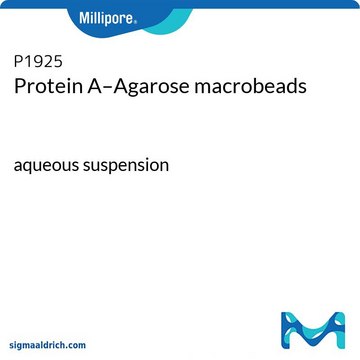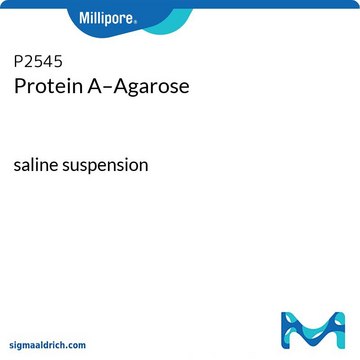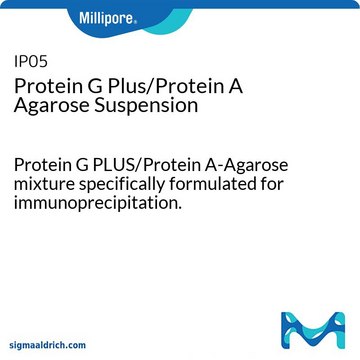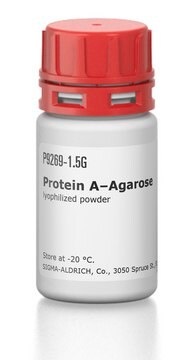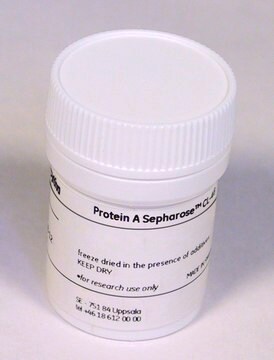IP02
Protein A Agarose Suspension
Protein A Agarose Suspension designed for immunoprecipitation applications
Anmeldenzur Ansicht organisationsspezifischer und vertraglich vereinbarter Preise
Alle Fotos(1)
About This Item
UNSPSC-Code:
41116133
NACRES:
NA.56
Empfohlene Produkte
Form
slurry (Liquid)
Enthält
≤0.1% sodium azide as preservative
Hersteller/Markenname
Calbiochem®
Lagerbedingungen
do not freeze
Versandbedingung
wet ice
Lagertemp.
2-8°C
Allgemeine Beschreibung
Designed for immunoprecipitation applications. This product is blocked with BSA to reduce non-specific binding and cannot be used for purification; best for mouse IgG2a and IgG2b and rabbit IgG.
Protein A conjugated to agarose.
Warnhinweis
Toxicity: Standard Handling (A)
Physikalische Form
In PBS.
Sonstige Hinweise
Agarose solutions are supplied ready-to-use for immunoprecipitation. Use 15 µl suspension/µg primary antibody. Protein A-Agarose is recommended for use in immunoprecipitation assays using rabbit polyclonal antibodies or unmodified mouse IgG2a or IgG2b monoclonal antibodies. Mouse IgG1 or IgG3 and all rat antibodies bind poorly to Protein A. As an alternative, use Protein G PLUS, Protein G PLUS/Protein A, or rabbit second-step antibodies to bridge these antibodies to Protein A. Preclearing will minimize extra bands resulting from nonspecific precipitation. To preclear, add to the sample 20 µl of agarose conjugate and 1 µg of normal IgG from the same species as the immunoprecipitating antibody. When immunoblotting is used for detection, some secondary antibodies can react nonspecifically with BSA or other proteins present at high concentrations in the sample. This can be eliminated by reducing the concentration of secondary antibody.
Rechtliche Hinweise
CALBIOCHEM is a registered trademark of Merck KGaA, Darmstadt, Germany
Lagerklassenschlüssel
11 - Combustible Solids
WGK
WGK 1
Flammpunkt (°F)
Not applicable
Flammpunkt (°C)
Not applicable
Analysenzertifikate (COA)
Suchen Sie nach Analysenzertifikate (COA), indem Sie die Lot-/Chargennummer des Produkts eingeben. Lot- und Chargennummern sind auf dem Produktetikett hinter den Wörtern ‘Lot’ oder ‘Batch’ (Lot oder Charge) zu finden.
Besitzen Sie dieses Produkt bereits?
In der Dokumentenbibliothek finden Sie die Dokumentation zu den Produkten, die Sie kürzlich erworben haben.
Kunden haben sich ebenfalls angesehen
Jonah Beenstock et al.
Molecular and cellular biology, 36(10), 1540-1554 (2016-03-16)
Many enzymes are self-regulated and can either inhibit or enhance their own catalytic activity. Enzymes that do both are extremely rare. Many protein kinases autoactivate by autophosphorylating specific sites at their activation loop and are inactivated by phosphatases. Although mitogen-activated
Derek W Stouth et al.
American journal of physiology. Cell physiology, 314(2), C177-C190 (2017-11-03)
Protein arginine methyltransferase 1 (PRMT1), PRMT4, and PRMT5 catalyze the methylation of arginine residues on target proteins. Previous work suggests that these enzymes regulate skeletal muscle plasticity. However, the function of PRMTs during disuse-induced muscle remodeling is unknown. The purpose
Lanlan Wei et al.
Biochemical and biophysical research communications, 368(2), 279-284 (2008-01-29)
The recruitment of the bromodomains of CREB-binding protein (CBP) and p300 by the acetylated myogenic transcription factor MyoD was previously shown to be critical for the enhanced MyoD transcriptional activity following acetylation at its Lys99 and Lys102 positions. However, the
Ajay Bhargava et al.
eLife, 5 (2016-02-18)
The Reproducibility Project: Cancer Biology seeks to address growing concerns about reproducibility in scientific research by conducting replications of selected experiments from a number of high-profile papers in the field of cancer biology. The papers, which were published between 2010
Vineet Kumar Maurya et al.
Journal of ovarian research, 7, 32-32 (2014-03-19)
Polycystic ovarian syndrome (PCOS) is characterized by the presence of multiple follicular cysts, giving rise to infertility due to anovulation. This syndrome affects about 10% of women, worldwide. The exact molecular mechanism leading to PCOS remains obscure. RhoGTPase has been
Unser Team von Wissenschaftlern verfügt über Erfahrung in allen Forschungsbereichen einschließlich Life Science, Materialwissenschaften, chemischer Synthese, Chromatographie, Analytik und vielen mehr..
Setzen Sie sich mit dem technischen Dienst in Verbindung.



